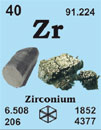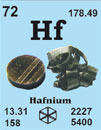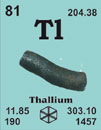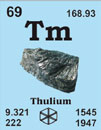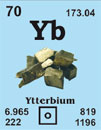Rhenium 75Re186.2
1925 von W. Noddack, Ida Tacke und O. Berg in Berlin, Deutschland, entdeckt.
[Lateinisch, Rhenus = Rhein]
French: Rhénium
English: Rhenium
Italian: Rhenio
Spanish: Rhenio
Beschreibung: Silberweißes Metall, gewöhnlich als graues Pulver erhältlich. Widerstandsfähig gegen Korrosion und Oxidation, aber läuft in feuchter Luft langsam an. Löst sich in Salpetersäure und Schwefelsäure. Verwednung: Heizdrähte, Thermistoren, Katalysatoren.
Rhenium single crystal properties
| State: |
Single crystal |
|---|
| Crystal structure: |
hexagonal |
|---|
| Production method: |
Floating zone |
|---|
| Standard size: |
diameter 6mm
thickness 1-2mm |
|---|
| Orientation: |
(0001), (1-100) and (11-20) |
|---|
| Orientation accuracy: |
<2°, <1°, <0.4° or <0.1° |
|---|
| Polishing: |
as cut, one or two sides polished |
|---|
| Roughness of surface: |
<0.03µm |
|---|
| Purity: |
99.99% |
|---|
| Typical analysis (ppm): |
C 3
H < 1
O 9
N < 5
Cu 1.60
Fe 1.80
Ni < 1
Pb 0.30
Si 0.30
Ga, Hf and Ta are below the detection limit
|
|---|
Materials properties
| Density: |
12.4 g/cm3 |
|---|
| Melting point: |
3179.85 °C / 3453 °K |
|---|
| Boiling point: |
5626.85 °C / 5900 °K |
|---|
| Molar volume: |
8.86 cm3 |
|---|
| Thermal conductivity: |
47.9 [300 K] Wm-1K-1 |
|---|
| Coefficient of linear thermal expansion: |
6.63 x 10-6 K-1 |
|---|
| Electrical resistivity: |
19.3x 10-8 [293 K] Wm |
|---|
| Mass magnetic susceptibility: |
+4.56 x 10-9(s) kg-1m3 |
|---|
| Young's modulus: |
466 GPa |
|---|
| Rigidity modulus: |
181 GPa |
|---|
| Bulk modulus: |
334 GPa |
|---|
| Poisson's ratio: |
0.26 GPa |
|---|
| Radii: |
Re7+ 60; Re6+ 61; Re4+ 72; atomic 137; covalent 12 |
|---|
| Electronegativity: |
1.9 (Pauling); 1.46 (Allred); 4.02 eV (absolute) |
|---|
| Effective nuclear charge: |
3.60 (Slater); 10.12 (Clementi); 14.62 (Froese-Fischer) |
|---|
| Number of Isotopes (incl. nuclear isomers): |
34 |
|---|
| Issotope mass range: |
162 -> 192 |
|---|
| Crystal structure, (cell dimentions / pm), space group |
hexagonal |
|---|
| X-ray diffraction: mass absorption coefficients: |
CuKα 179 (µ/r) / cm2g-1
MoKα 103 (µ/r) / cm2g-1 |
|---|
| Neutron scattering length: |
0.92 b/10-12 cm |
|---|
| Thermal neutron capture cross-section: |
89.7 sa / barns |
|---|
Biological data
| Biological role: |
none |
|---|
| Toxicity |
|
|---|
| Toxic intake: |
n.a. |
|---|
| Lethal intake: |
LD50 (ReCl3, intraperitoneal, mouse)= 280 mg kg-1 |
|---|
| Hazards: |
There are no reported cases of humans beeing affected by rhenium. Like other powdered metals, rhenium dust could pose a moderate fire or explosion hazard. |
|---|
| Level in humans |
|
|---|
| Blood: |
|
|---|
| Bone: |
|
|---|
| Liver: |
|
|---|
| Muscle: |
|
|---|
| Daily dietary intake: |
n.a. |
|---|
| Total mass of element in average [70 kg] person: |
n.a., but very low |
|---|
Geological data
| Mineral | Formula | Density | Hardness | Crystal apperance |
|---|
| Chief ore: |
Rhenium is extracted from the flue dusts of molybdenum smelters. |
|---|
| World production: |
4.5 tonnes/year |
|---|
| Main mining areas: |
see molybdenum |
|---|
| Reserves: |
3500 tonnes |
|---|
| Specimen: |
available as foil, powder, ribbon or wire. CARE ! |
|---|
| Abundances |
|
|---|
| Sun: |
<2 (relative to H = 1 x 1012) |
|---|
| Earth's crust: |
4 x 10-4 p.p.m. |
|---|
| Seawater: |
|
|---|
| Residence time: |
|
|---|
| Classification: |
|
|---|
| Oxidation state: |
III |
|---|

 English
English
 Deutsch
Deutsch








































